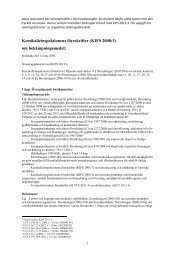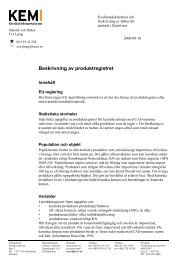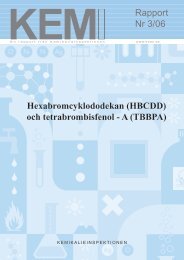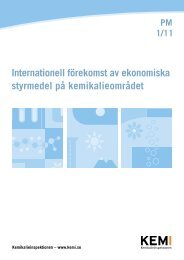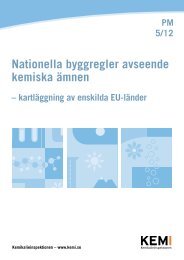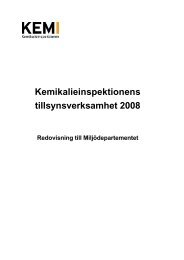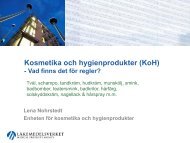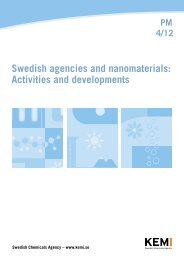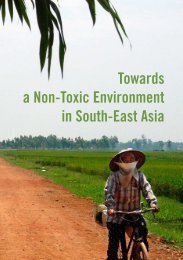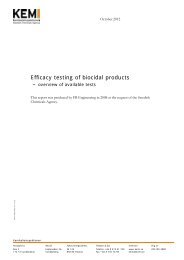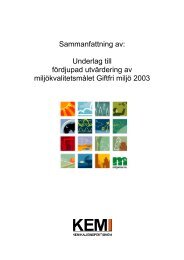Kemikalier och klimat - Kemikalieinspektionen
Kemikalier och klimat - Kemikalieinspektionen
Kemikalier och klimat - Kemikalieinspektionen
You also want an ePaper? Increase the reach of your titles
YUMPU automatically turns print PDFs into web optimized ePapers that Google loves.
2. English Summary<br />
On synergies and conflicts between Reduced Climate Impact and A non-toxic<br />
Environment - A Preparatory Study<br />
The manufacture and use of chemicals accounts for about one tenth of all<br />
anthropogenic greenhouse gas emissions. Today’s chemicals are almost<br />
exclusively made from fossil materials – leading to CO2-emissions when<br />
degrading. Chemicals manufacture is generally energy intensive and heavily<br />
dependent of fossil fuels. In addition, several manmade chemicals degrade<br />
only slowly in the atmosphere, causing greenhouse effects by themselves.<br />
The effect of such long-lived substances might in extreme cases be several<br />
thousands times higher than that of carbon dioxide, per unit.<br />
But chemicals are also crucial for evolving technical solutions to curb<br />
climate change. Advanced energy technology for instance - such as<br />
photovoltaic cells, energy storage equipment, and insulation materials –<br />
requires high efficiency chemicals to deliver. Some of these solutions are<br />
making use of clearly toxic chemicals - such as mercury in energy efficiency<br />
light bulbs. Large scale climate investments in various technological<br />
solutions might therefore lead to widespread emissions of toxic chemicals.<br />
On the other hand, the transition from a fossil fuel based production towards<br />
bio-based sources creates opportunities to introduce less toxic chemicals, e g<br />
by mimicking biological processes through “white biotechnology” processes.<br />
These aspects make it crucial to discuss chemicals production and use not<br />
only from a toxicological perspective, but also in relation to climate change.<br />
Questions should be raised regarding what kind of feedstock to be used, how<br />
chemicals with GHG potential can be avoided, etc.<br />
The relation between climate and chemicals has not been thoroughly<br />
investigated or discussed. The Swedish Chemicals Agency (KEMI) has<br />
therefore requested this preparatory study to be produced, to consider various<br />
aspects of chemicals in relations to the climate issue. The report describes<br />
both synergetic and conflicting issues. The report also suggests measures to<br />
take the issue forward on the national (Swedish) and international arena.<br />
Examples of synergies include the following:<br />
– Reduced extraction of fossil materials decreases the release of toxic<br />
compounds bound to the earth crust. One example being mercury<br />
present in trace amounts in fossil coal. Increased energy efficiency and<br />
transforming society to use more bio-based fuels will decrease the<br />
release of toxic substances from fossil materials.<br />
– Refined petroleum products, such as gasoline, contain a broad mixture of<br />
cancerogenic and mutagenic substances. Reducing the use of gasoline<br />
will reduce the output of health threatening chemicals, given that the<br />
alternatives used are less toxic.<br />
– The development of “industrial biotechnology” (which is based on<br />
biological processes) reduces the need for fossil fuels as feedstock,<br />
increases the yield in conventional production. Simultaneously, products<br />
generated tend to be less toxic.<br />
10



